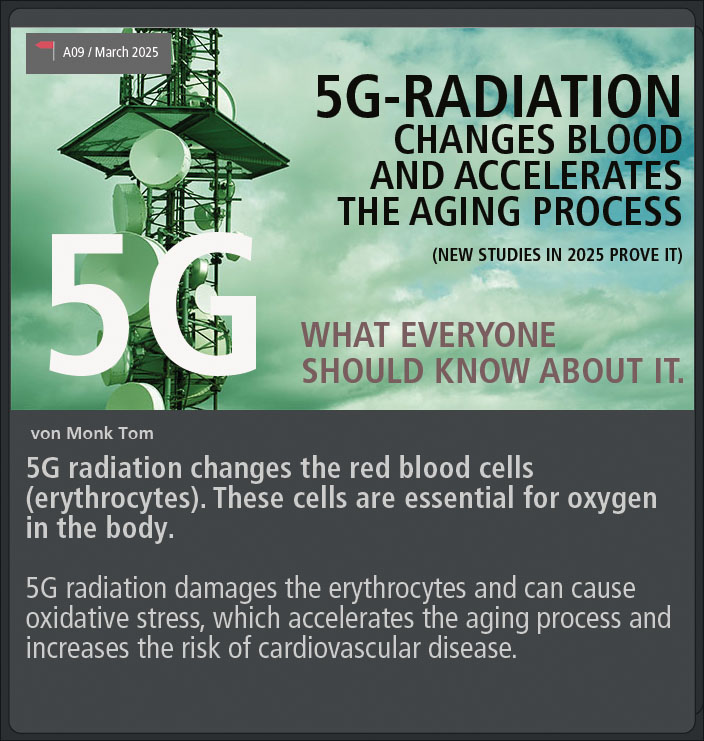5G-RADIATION CHANGES BLOOD AND ACCELERATES THE AGING PROCESS


By Monk Tom
The introduction of 5G technology has ushered in a new era of digital networking. With high data throughput and low latency, 5G promises a revolution in areas such as autonomous driving, telemedicine, and smart cities.
However, alongside technological advancements, there are growing concerns about potential health risks.
A recent study, published in the journal Biomedicines , sheds new light on the effects of 5G high-frequency radiation (RF-EMR) on human blood—particularly on red blood cells (erythrocytes).
The results are alarming and raise important questions about the interface between technology and health.
Overview of the Study
The researchers, led by Nikolino Žura, investigated the effects of short-term exposure to 5G frequencies (700 MHz, 2500 MHz, and 3500 MHz) on human blood. For the study, blood samples were taken from 30 healthy volunteers (15 women and 15 men aged 25 to 40 years) and exposed in vitro to various 5G frequencies for two hours. The samples were analyzed under controlled laboratory conditions to examine changes in the complete blood count (CBC), platelet activation, and erythrocyte morphometry.
No Significant Changes in CBC or Platelets
Surprisingly, the analyses showed no significant changes in the complete blood count or platelet activation. Parameters such as the number of white blood cells (leukocytes), red blood cells (erythrocytes), and platelets remained unaffected. The blood's clotting ability was also not impaired by the exposure. This could indicate that 5G radiation has no direct effects on these fundamental blood parameters, at least in the short term.
Profound Changes in Erythrocytes
Although the CBC remained unchanged, microscopic analyses revealed significant changes in the morphometry of erythrocytes. These cells are essential for oxygen transport in the body, and their shape and mechanical flexibility are crucial for efficient blood flow. The study documented the following effects:
1. 700 MHz Exposure
At this frequency, both genders showed significant enlargement of erythrocytes, increased membrane roughness, and enhanced rounding. Notably, female erythrocytes were more sensitive compared to those of males. While male cells exhibited greater membrane roughness, female cells showed larger morphological changes.
2. 2500 MHz Exposure
At this frequency, the contour index of erythrocytes increased, while solidity and form factor decreased. These effects were more pronounced in women than in men. Particularly, increased membrane permeability was observed, indicating a mechanical disruption of the cell membrane.
3. 3500 MHz Exposure
The highest tested frequency led to further deterioration of erythrocyte morphology. Women showed a marked increase in membrane roughness, reduced solidity, and diminished elongation. These changes may impair the cells' ability to pass through narrow capillaries, potentially affecting tissue oxygen supply.
Gender-Specific Differences
A remarkable finding of the study is the gender-specific susceptibility of erythrocytes. Female cells proved to be more sensitive to 5G radiation, especially at lower frequencies like 700 MHz. Possible explanations lie in hormonal differences that may influence the fluidity and resilience of the erythrocyte membrane. Male erythrocytes, on the other hand, showed less shape distortion but greater membrane roughness, possibly due to differences in membrane lipid composition or testosterone-influenced protein dynamics.
Health Consequences
The observed changes in erythrocyte morphometry could have serious health consequences. Erythrocytes are known for their biconcave shape, which allows them to efficiently pass through narrow vessels and transport oxygen. If this shape is disrupted—such as through oxidative damage or mechanical disturbances—it can lead to reduced deformability. This, in turn, can impair tissue oxygen supply and increase the risk of cardiovascular diseases.
Another aspect is the accelerated aging of erythrocytes.
The study suggests that 5G radiation can accelerate the aging process of cells by weakening the cytoskeletal structure and increasing membrane permeability. In the long term, this can lead to a shorter life cycle of erythrocytes and negatively impact overall health.
Reversibility of Changes
An open question remains whether the observed changes are reversible. In an earlier study by Nguyen et al. (2020), it was shown that the membrane permeability of rabbit erythrocytes normalized within 10 minutes after short exposure to high-frequency electromagnetic fields. However, the exposure parameters of that study differ significantly from those of the current investigation, so no direct conclusions can be drawn. Further research is necessary to better understand the temporal dynamics of erythrocyte responses.
Conclusion:
A Call for Precaution
The study by Žura et al. provides important evidence that 5G high-frequency radiation can have profound effects on human blood even with short-term exposure. While the complete blood count and platelet activation remain unaffected, the microscopic changes in erythrocytes show that the radiation may have subtle but significant effects on cell structure.
Particularly concerning is the gender-specific susceptibility, which points to individual risk factors.
These findings should be seen as a warning signal, and policymakers should adopt precautionary measures. These include stricter limits, transparent risk communication, and the promotion of independent research.
Only in this way can we harness the benefits of 5G technology without jeopardizing our health.
The future lies in balancing innovation and safety—and only through responsible handling of technology can we reconcile both aspects.
